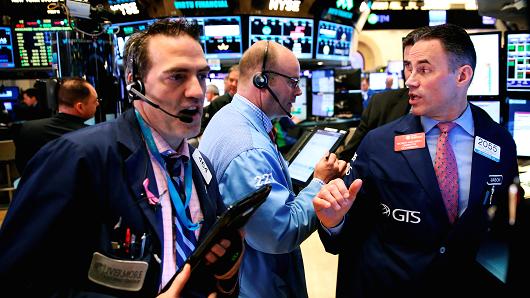
U.S. stocks whipsawed on Wednesday after the Federal Reserve upgraded its economic outlook and increased interest rates. The central bank also increased its rate-hike forecast for next year.
The Dow Jones industrial average closed 44.96 points lower at 24,682.31, with Apple as the biggest decliner in the index. The Dow rose as much as 250.38 points during the session. The S&P 500 slipped 0.2 percent to 2,711.93 as consumer staples declined 1.3 percent. At its session high, the broad index had risen 0.8 percent. The Nasdaq composite fell 0.3 percent to 7,345.29 after gaining as much as 0.6 percent.
Stocks hit session highs shortly after the Fed made its monetary-policy announcement.
“The initial reaction in stock was because the median dot plot didn’t go up for 2018,” said James Athey, senior investment manager at Aberdeen Standard Investments. “Then there was the more concerned reaction, with investors saying: ‘Hold on, there’s one more rate hike in for 2019.'”
The Fed raised overnight rates by 25 basis points, in line with market expectations. Central bank officials also raised their GDP forecast.
“The economic outlook has strengthened in recent months,” the committee said in its post-meeting statement, a sentence that had not been in previous releases. “Job gains have been strong in recent months, and the unemployment rate has stayed low.”
Fed officials also released their projections for the federal funds rate, which remained unchanged for 2018. The central bank, however, raised its 2019 forecast, saying it sees the benchmark rate at 2.9 percent, up from a 2.7 percent projection released in December.
In the statement, Chair Jerome Powell “delivered what the market was expecting, albeit with a more hawkish tone,” said Randy Anderson, chief economist at Griffin Capital. “I think they’ve overstated the economic strength for 2019. What they’re doing is looking in the rear-view mirror to the Trump administration’s tax and infrastructure policies, which can boost GDP in the short term, but can also lead to increases in debt and deficits. Those can put a short circuit in the economy.”
Treasury yields briefly rose after the Fed announcement. The benchmark 10-year yield broke above 2.9 percent before retreating to trade at 2.887 percent. The two-year yield also slipped from a nine-year high.
Bank stocks also whipsawed following the statement’s release. The SPDR S&P exchange-traded fund (KBE) rose more than 1 percent before closing 0.2 percent higher.
Powell also held his first news conference as chair. In it, he raised a flag about President Donald Trump’s trade policies.
“A number of participants in the [Federal Open Market Committee] did bring up the issue of tariffs,” Powell said. “If I could summarize what came out of it was, first, there’s no thought that changes in trade policy should have any effect on the current outlook.”
However, “a number of participants reported that about their conversations with business leaders around the country and reported that trade policy has come a concern going forward for that growth.”
Equities have been under pressure recently as the Trump administration ramps up a protectionist trade agenda. CNBC reported earlier on Wednesday, citing sources, that the White House will announce later this week tariffs cracking down on Chinese theft of intellectual property.
In corporate news, Facebook shares bounced off the week’s lows with a 0.8 percent gain as some top investors said the recent sell-off reflects a temporary issue.
The social media giant faces an investor lawsuit after reports emerged alleging that Cambridge Analytica, an analytics company, had gathered data from 50 million Facebook profiles without the permission of its users.
General Mills, meanwhile, fell nearly 10 percent after the company trimmed its adjusted earnings growth forecast.
